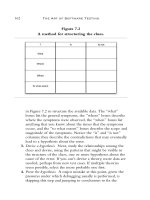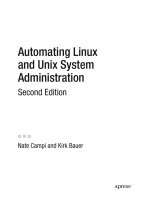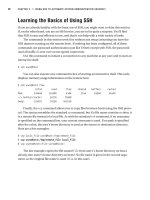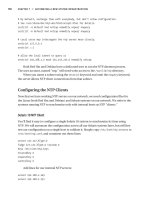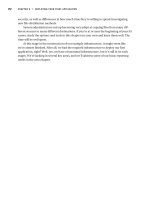Automating Linux and Unix System Administration Second Edition phần 8 pptx
Bạn đang xem bản rút gọn của tài liệu. Xem và tải ngay bản đầy đủ của tài liệu tại đây (222.33 KB, 44 trang )
CHAPTER 10 MONITORING
296
Figure 10-1. Nagios service detail screen for the system localhost
in our case), and it has an object configuration file called
hk_]hdkop*_bc that sets up the
checks you see on that page.
?NEPE?=H state) for the HTTP service, because we
-
step 14.
Step 14: Modifying the Nagios Localhost-Only Monitoring to Check HTTPS
The etchlamp),
since only the host localhost has checks defined in the default Nagios configuration files.
LNK@+nalh+nkkp+qon+lgc+j]ceko)_kjb+k^fa_po+
hk_]hdkop*_bc in order to properly monitor HTTPS on this host:
CHAPTER 10 MONITORING
297
`abejaoanre_aw
qoahk_]h)oanre_a7oanre_apailh]papkqoa
dkop[j]iahk_]hdkop
oanre_a[`ao_nelpekjDPPL
_da_g[_kii]j`_da_g[dppl
jkpebe_]pekjo[aj]^ha`,
y
`abejaoanre_aw
qoahk_]h)oanre_a7oanre_apailh]papkqoa
dkop[j]iahk_]hdkop
oanre_a[`ao_nelpekjDPPLO
_da_g[_kii]j`_da_g[dpplo00/+
jkpebe_]pekjo[aj]^ha`,
y
If you’re following along with the book in an environment of your own, you’ll notice
a problem—there isn’t a
_da_g[dpplo
addition to
LNK@+nalh+nkkp+qon+lgc+j]ceko)_kjb+k^fa_po+_kii]j`o*_bc:
`abeja_kii]j`w
_kii]j`[j]ia_da_g[dpplo
_kii]j`[heja QOAN- +_da_g[dppl)O)H)D DKOPJ=IA )l =NC- )q =NC.
y
This new _kii]j` object definition calls the _da_g[dppl plug-in with the appropriate
arguments to test an HTTPS-enabled web site. Once this was copied to our Nagios server
the check cleared in Nagios.
Nagios is now in a fully functional state in our environment, but we don’t find it very
useful to only monitor a single machine. Next, we’ll take steps to monitor the rest of the
hosts at our site. The first step will be to deploy a local monitoring agent called NRPE to
all our systems.
NRPE
NRPE is the Nagios Remote Plug-in Executor. It is used in place of agents and protocols
such as SNMP for remotely monitoring hosts. It grants access to remote hosts to execute
plug-ins such as those in the Nagios plug-ins distribution. NRPE has two components: a
daemon called
jnla and a plug-in to the Nagios daemon called _da_g[jnla.
CHAPTER 10 MONITORING
298
The NRPE documentation points out that there are other ways to accomplish remote
plug-in execution, such as the Nagios
_da_g[^u[ood
host seems attractive for security reasons, it imposes more overhead on remote hosts
than the NRPE program does. In addition, a site’s security policy may expressly forbid
lightweight, flexible, and fast.
Step 15: Building NRPE
The NRPE source distribution does not include an installation facility. Once it is built, it
-
ated a single new directory under LNK@+nalh+nkkp+qon+lgc to house the NRPE binaries for
each of our platforms:
LNK@+nalh+nkkp+qon+lgc+jnla).* )^ej.
Now we need to build NRPE so that we have something to place in this new directory.
scapdppl6++ejpanj]l*`h*okqn_abknca*jap+okqn_abknca+j]ceko+jnla).* *p]n*cv
cqjvel)_jnla).* *p]n*cvxp]ntb)
_`jnla).*
*+_kjbecqna))aj]^ha)ooh""i]ga]hh
_`on_
o_ljnlackh`i]opan6+r]n+he^+_bajceja.+i]opanbehao+LNK@+nalh+nkkp+qon+lgc+
jnla).* )^ej+jnla)`a^e]j*e242
o_l_da_g[jnlackh`i]opan6+r]n+he^+_bajceja.+i]opanbehao+LNK@+nalh+nkkp+qon+
lgc+j]ceko)lhqcejo)-*0* )`a^e]j*e242+he^ata_+
_da_g[jnla to the preexisting j]ceko)lhqcejo directory for the `a^e]j*e242
architecture and copied the
jnla program itself into the single shared LNK@+nalh+nkkp+qon+
lgc+jnla).* )^ej directory.
except that we copied the plug-ins to the
jnla)^ej+jnla)na`d]p*e242 directory and the
jnla binary to jnla).* )^ej+jnla)na`d]p*e242.
jnla*_,
because the code assumes that all UNIX-like systems have the same syslog facilities as
2-2+&ahoaeb$opn_il$r]nr]hqa(]qpdlner%%
2-3hkc[b]_ehepu9HKC[=QPDLNER7
2-4ahoaeb$opn_il$r]nr]hqa(bpl%%
2-5hkc[b]_ehepu9HKC[BPL7&+
CHAPTER 10 MONITORING
299
master with these commands:
*+_kjbecqna))aj]^ha)ooh))sepd)ooh9+qon+obs))sepd)ooh)he^9+qon+obs+he^""X
i]ga]hh
_`on_
o_ljnlackh`i]opan6+r]n+he^+_bajceja.+i]opanbehao+LNK@+nalh+nkkp+qon+lgc+
jnla).* )^ej+jnla)oqjko[oqj0q
o_l_da_g[jnlackh`i]opan6+r]n+he^+_bajceja.+i]opanbehao+LNK@+nalh+nkkp+
qon+lgc+j]ceko)lhqcejo)-*0* )oqjko*oqj0q+he^ata_+
The preceding _kjbecqna
master as shown.
Step 16: Creating an NRPE Configuration File
o]ilha)_kj)
bec+jnla*_bc) to the cfengine master at LNK@+nalh+nkkp+qon+lgc+jnla)_kjb+jnla*_bc
then edited the
jnla*_bc file to use the +qon+lgc+j]ceko)lhqcejo+he^ata_ directory for all
the paths and allow access from our etchlamp system as shown:
oq^opepqpaukqnikjepknejcdkop#oELbkn-5.*-24*-*./5
]hhksa`[dkopo9 3*,*,*-(-5.*-24*-*./5
Pdabkhhksejcat]ilhaoqoad]n`_k`a`_kii]j`]ncqiajpo***
_kii]j`W_da_g[qoanoY9+qon+lgc+j]ceko)lhqcejo+he^ata_+_da_g[qoano)s1)_-,
_kii]j`W_da_g[hk]`Y9+qon+lgc+j]ceko)lhqcejo+he^ata_+_da_g[hk]`)s-1(-,(1
)_/,(.1(.,
_kii]j`W_da_g[d`]-Y9+qon+lgc+j]ceko)lhqcejo+he^ata_+_da_g[`eog)s.,!
)_-,!)l+`ar+d`]-
_kii]j`W_da_g[vki^ea[lnk_oY9+qon+lgc+j]ceko)lhqcejo+he^ata_+_da_g[lnk_o)s1
)_-,)oV
_kii]j`W_da_g[pkp]h[lnk_oY9+qon+lgc+j]ceko)lhqcejo+he^ata_+_da_g[lnk_o)s-1,)_.,,
At this point, we have the NRPE programs built and ready for distribution from the
cfengine master, along with a configuration file. The last thing we need to prepare for
NRPE is a start-up script.
CHAPTER 10 MONITORING
300
Step 17: Creating an NRPE Start-up Script
created a simple init script for NRPE at LNK@+nalh+nkkp+ap_+ejep*`+jnla on the
cfengine master with these contents:
+^ej+od
L=PD9+^ej6+qon+^ej
_]oa -ej
op]np%
+qon+lgc+jnla+o^ej+jnla)_+qon+lgc+jnla+ap_+jnla*_bc)`
77
naop]np%
gehh\_]p+r]n+nqj+jnla*le`\
lgehh)5)bjnla)_+qon+lgc+jnla+ap_+jnla*_bc)`
+qon+lgc+jnla+o^ej+jnla)_+qon+lgc+jnla+ap_+jnla*_bc)`
77
opkl%
gehh\_]p+r]n+nqj+jnla*le`\
lgehh)5)bjnla)_+qon+lgc+jnla+ap_+jnla*_bc)`
77
&%
a_dkQo]ca6 ,wop]npxopklxnaop]npy
atep-
77
ao]_
atep,
This is a very simple init script, but it suffices because NRPE is a very simple daemon.
lgehh command, because in writing this chapter, we found that occasion-
ally the PID of the
jnla process wasn’t properly stored in the jnla*le` file. Occasionally,
daemons have bugs such as this, so we simply work around it with some extra measures
to kill the daemon with the
lgehh command.
Step 18: Copying NRPE Using cfengine
now have everything we need to deploy NRPE at our site. To distribute NRPE with
cfengine, we created a task to distribute the configuration file, init script, and binaries in
a file named
LNK@+ejlqpo+p]ogo+]ll+j]ceko+_b*jnla[ouj_. Here’s the file, which we will
describe only briefly after showing the complete contents, because we’re not introducing
any new cfengine functionality in this task:
CHAPTER 10 MONITORING
301
_kjpnkh6
]ju66
]``ejop]hh]^ha9$naop]np[jnla%
jnla[ran9$jnla).* %
_klu6
`a^e]j*e24266
$i]opan%+nalh+nkkp+qon+lgc+ $jnla[ran%)^ej+jnla)`a^e]j*e242
`aop9+qon+lgc+ $jnla[ran%+o^ej+jnla
ik`a9311
ksjan9j]ceko
cnkql9j]ceko
ecjkna9ns
at_hq`a9ns
pula9_da_goqi
oanran9 $behaoanran%
aj_nulp9pnqa
`abeja9naop]np[jnla
na`d]p*e24266
$i]opan%+nalh+nkkp+qon+lgc+ $jnla[ran%)^ej+jnla)na`d]p*e242
`aop9+qon+lgc+ $jnla[ran%+o^ej+jnla
ik`a9311
ksjan9j]ceko
cnkql9j]ceko
ecjkna9ns
at_hq`a9ns
pula9_da_goqi
oanran9 $behaoanran%
aj_nulp9pnqa
`abeja9naop]np[jnla
oqjko[oqj0q66
$i]opan%+nalh+nkkp+qon+lgc+ $jnla[ran%)^ej+jnla)oqjko*oqj0q
`aop9+qon+lgc+ $jnla[ran%+o^ej+jnla
ik`a9311
ksjan9j]ceko
cnkql9j]ceko
pula9_da_goqi
oanran9 $behaoanran%
aj_nulp9pnqa
`abeja9naop]np[jnla
CHAPTER 10 MONITORING
302
]ju66
$i]opan%+nalh+nkkp+ap_+ejep*`+jnla
`aop9+ap_+ejep*`+jnla
ik`a9311
ksjan9nkkp
cnkql9nkkp
pula9_da_goqi
oanran9 $behaoanran%
aj_nulp9pnqa
`abeja9naop]np[jnla
$i]opan%+nalh+nkkp+qon+lgc+jnla)_kjb+jnla*_bc
`aop9+qon+lgc+jnla+ap_+jnla*_bc
ik`a9311
ksjan9j]ceko
cnkql9j]ceko
ecjkna9ns
at_hq`a9ns
pula9_da_goqi
oanran9 $behaoanran%
aj_nulp9pnqa
`abeja9naop]np[jnla
odahh_kii]j`o6
naop]np[jnla66
+ap_+ejep*`+jnlanaop]nppeiakqp92,ejbkni9pnqa
`ena_pkneao6
]ju66
+qon+lgc+ $jnla[ran%+o^eji9331ksjan9j]ceko
cnkql9j]c_i`ejbkni9b]hoa
+qon+lgc+ $jnla[ran%+ap_i9331ksjan9j]ceko
cnkql9j]c_i`ejbkni9b]hoa
lnk_aooao6
]ju66
jnlanaop]np+ap_+ejep*`+jnlaop]npejbkni9pnqaqi]og9,
CHAPTER 10 MONITORING
303
hejgo6
]ju66
+qon+lgc+jnla):+qon+lgc+ $jnla[ran%
n_o_nelpo
+ap_+n_,*`+G,.jnla):+ap_+ejep*`+jnla
+ap_+n_-*`+G,.jnla):+ap_+ejep*`+jnla
+ap_+n_.*`+O54jnla):+ap_+ejep*`+jnla
]ju*$okh]neoxokh]neot42%66
+ap_+n_/*`+O54jnla):+ap_+ejep*`+jnla
+ap_+n_0*`+O54jnla):+ap_+ejep*`+jnla
+ap_+n_1*`+O54jnla):+ap_+ejep*`+jnla
+ap_+n_2*`+G,.jnla):+ap_+ejep*`+jnla
+ap_+ejep*`+jnla start-up script into the runlevel-specific directo-
ries in the preceding
hejgo section, we avoid creating a link in +ap_+n_/*` on Solaris hosts.
+ap_+n_.*`+ and +ap_+n_/*`+
execute twice. No damage would result, but we don’t want to be sloppy.
directories n_0*`, n_1*`, and n_2*` don't exist on Solaris, so we won't attempt to create sym-
links in them.
Note that we make it easy to move to a newer version of NRPE later on, using version
numbers and a symlink at
+qon+lgc+jnla to point to the current version. The use of a vari-
able means only the single entry in this task will need to change once a new NRPE version
is built and placed in the appropriate directories on the cfengine master.
To activate this new task, we placed the following line in
LNK@+ejlqpo+dkopcnkqlo+
_b*]ju:
p]ogo+]ll+j]ceko+_b*jnla[ouj_
Step 19: Configuring the Red Hat Local Firewall to Allow NRPE
The next-to-last step we had to take was to allow NRPE connections through the Red Hat
firewall. To do so, we added rules directly to the
+ap_+ouo_kjbec+elp]^hao file on the sys-
tem rhlamp and restarted
elp]^hao with oanre_aelp]^haonaop]np. Here are the complete
contents of the
elp]^hao file, with the newly added line in bold:
CHAPTER 10 MONITORING
304
&behpan
6EJLQP=??ALPW,6,Y
6BKNS=N@=??ALPW,6,Y
6KQPLQP=??ALPW,6,Y
6ND)Benas]hh)-)EJLQP)W,6,Y
)=EJLQP)fND)Benas]hh)-)EJLQP
)=BKNS=N@)fND)Benas]hh)-)EJLQP
)=ND)Benas]hh)-)EJLQP)ehk)f=??ALP
)=ND)Benas]hh)-)EJLQP)le_il))e_il)pula]ju)f=??ALP
)=ND)Benas]hh)-)EJLQP)l1,)f=??ALP
)=ND)Benas]hh)-)EJLQP)l1-)f=??ALP
)=ND)Benas]hh)-)EJLQP)lq`l))`lknp1/1/)` 0*,*,*.1-)f=??ALP
)=ND)Benas]hh)-)EJLQP)lq`l)iq`l))`lknp2/-)f=??ALP
)=ND)Benas]hh)-)EJLQP)lp_l)ip_l))`lknp2/-)f=??ALP
)=ND)Benas]hh)-)EJLQP)iop]pa))op]paAOP=>HEODA@(NAH=PA@)f=??ALP
)=ND)Benas]hh)-)EJLQP)iop]pa))op]paJAS)ip_l)lp_l))`lknp )f=??ALP
)=ND)Benas]hh)-)EJLQP)iop]pa))op]paJAS)ip_l)lp_l))`lknp4,)f=??ALP
)=ND)Benas]hh)-)EJLQP)iop]pa))op]paJAS)ip_l)lp_l))`lknp00/)f=??ALP
)=ND)Benas]hh)-)EJLQP)iop]pa))op]paJAS)ip_l)lp_l))`lknp1222)f=??ALP
)=ND)Benas]hh)-)EJLQP)fNAFA?P))nafa_p)sepde_il)dkop)lnkde^epa`
?KIIEP
decided to enforce the contents of this file using cfengine. This decision will disallow the
future use of utilities such as
ouopai)_kjbec)oa_qnepuharah to manage the host’s firewall
rules, but that’s good. Stringent enforcement of the iptables file contents will force the
always use the Red Hat command
ouopai)_kjbec)oa_qnepuharah to make changes and then
feed the resulting
+ap_+ouo_kjbec+elp]^hao changes back into the copy that we distribute
with cfengine. This is just another example of how manual changes are often needed to
determine how to automate something. It’s always OK as long as we feed the resulting
changes and steps back into cfengine for long-term enforcement.
elp]^hao file on our cfengine master at LNK@+nalh+nkkp+ap_+ouo_kjbec+
elp]^hao and placed a task with these contents at the location LNK@+ejlqpo+p]ogo+ko+
_b*elp]^hao[ouj_:
_kjpnkh6
]ju66
]``ejop]hh]^ha9$naop]npelp]^hao%
CHAPTER 10 MONITORING
305
_klu6
na`d]p66
$i]opan[ap_%+ouo_kjbec+elp]^hao
`aop9+ap_+ouo_kjbec+elp]^hao
ik`a9000
ksjan9nkkp
cnkql9nkkp
oanran9 $behaoanran%
pnqopgau9pnqa
pula9_da_goqi
aj_nulp9pnqa
`abeja9naop]npelp]^hao
odahh_kii]j`o6
na`d]p*naop]npelp]^hao66
sdaj_kjbeceoql`]pa`(naop]npelp]^hao
+o^ej+oanre_aelp]^haonaop]np
peiakqp92,ejbkni9pnqa
dkopckql for Red Hat systems by adding this line to LNK@+ejlqpo+
dkopcnkqlo+_b*dkopcnkql[i]llejco:
na`d]p66dkopcnkqlo+_b*na`d]p
Then, we created a dkopcnkql file at LNK@+ejlqpo+dkopcnkqlo+_b*na`d]p with these
contents:
eilknp6
]ju66
p]ogo+ko+_b*elp]^hao[ouj_
It might seem strange to use the ]ju class in the _b*na`d]p hostgroup file, but if you
think about it, the task doesn’t apply to all hosts on our network, only to the hosts that
import this dkopcnkql file. That means that this ]ju66 class will actually apply to only Red
Hat systems.
Now, sit back and let NRPE go out to your network. If you encounter any issues while
building NRPE, refer to the
JNLA*l`b file included in the `k_o directory of the NRPE source
distribution.
CHAPTER 10 MONITORING
306
Monitoring Remote Systems
So far, we’re simply using the example configuration included with Nagios to monitor
only the system that is actually running Nagios. To make Nagios generally useful, we need
to monitor remote systems.
wish to remind you that Nagios is very flexible, and perhaps because of that, it is rather
complicated. There is no substitute for experience, so dig in with us and start becoming
familiar with it right away!
Step 20: Configuring Nagios to Monitor All Hosts at Our Example Site
master and have Nagios look for configuration files in this new directory:
ig`enLNK@+nalh+nkkp+qon+lgc+j]ceko)_kjb+k^fa_po+oanrano+
Edit LNK@+nalh+nkkp+qon+lgc+j]ceko)_kjb+j]ceko*_bc, and uncomment this line:
_bc[`en9+qon+lgc+j]ceko+ap_+oanrano
Then, change it so that it looks like this:
_bc[`en9+qon+lgc+j]ceko+ap_+k^fa_po+oanrano
You should also change the default ]`iej[ai]eh and ]`iej[l]can addresses in j]ceko*
_kjb to something appropriate for your site:
]`iej[ai]eh9]`iejo<at]ilha*knc
]`iej[l]can9]`iejo<at]ilha*knc
j]ceko*_kjb
for the regular expressions that we use later in service object definitions):
qoa[nacatl[i]p_dejc9-
hejqt)oanran template in LNK@+nalh+nkkp+qon+lgc+j]ceko)_kjb+k^fa_po+
pailh]pao*_bc to a second similar section to create a new qjet)oanran template that is set
qjet)oanran template definition:
CHAPTER 10 MONITORING
307
`abejadkopw
j]iaqjet)oanran7Pdaj]iakbpdeodkoppailh]pa
qoacajane_)dkop7ejdanepobnkicajane_)dkoppailh]pa
_da_g[lanek`.0t37Qjetdkopo]na_da_ga`nkqj`pda_hk_g
_da_g[ejpanr]h17=_perahu_da_gpdadkoparanu1iejqpao
napnu[ejpanr]h-7O_da`qhadkop_da_gnapneaoaranuiejqpa
i]t[_da_g[]ppailpo-,7?da_ga]_dHejqtdkop-,peiao$i]t%
_da_g[_kii]j`_da_g)dkop)]hera7@ab]qhp_kii]j`pk_da_gQjetdkopo
jkpebe_]pekj[lanek`.0t37=hs]uo]h]ni
jkpebe_]pekj[ejpanr]h ,7Naoaj`jkpebe_]pekjoaranu.dkqno
jkpebe_]pekj[klpekjo`(q(n7jkpebubknola_ebe_dkopop]pao
_kjp]_p[cnkqlo]`iejo7Jkpebu]`iejo^u`ab]qhp
naceopan,7@KJPNACEOPAN)EPOFQOP=PAILH=PA
y
Templates are used in Nagios to avoid repeating the same values for every service
and host object. These objects have many required entries, but Nagios allows the use of
every required value in the objects that we define. Template definitions are very similar
to the host or service definitions that they are meant for, but templates contain the line
naceopan, to keep Nagios from loading it as a real object. Any or all values can be over-
Note Be aware that ao_]h]pekj settings override the _kjp]_p[cnkqlo setting in service definitions.
We have no
ao_]h]pekj settings and won’t configure it in this chapter, but keep them in mind for your own
configurations.
Now that we have a template that suits our needs, we can inherit from it in our ser-
vice definitions and specify only important values or those that we wish to override from
the template’s values.
In the directory
LNK@+nalh+nkkp+qon+lgc+j]ceko)_kjb+k^fa_po+oanrano, we have four
files to define the objects to monitor on our network:
dkopo*_bc
dkopcnkqlo*_bc
ouopai[_da_go*_bc
sa^[_da_go*_bc
CHAPTER 10 MONITORING
308
the hosts at our site in the file dkopo*_bc:
`abejadkopw
qoaqjet)oanran
dkop[j]iadaiejcs]u*_]ilej*jap
y
`abejadkopw
qoaqjet)oanran
dkop[j]iackh`i]opan*_]ilej*jap
y
`abejadkopw
qoaqjet)oanran
dkop[j]ia]qnkn]*_]ilej*jap
y
`abejadkopw
qoaqjet)oanran
dkop[j]iandh]il*_]ilej*jap
y
`abejadkopw
qoaqjet)oanran
dkop[j]iandi]opan*_]ilej*jap
y
`abejadkopw
qoaqjet)oanran
dkop[j]iahkcdkop-*_]ilej*jap
y
`abejadkopw
qoaqjet)oanran
dkop[j]iaap_dh]il*_]ilej*jap
y
-
posely leave out that IP address because we want Nagios to use the DNS to find it, for
two reasons:
want to mask broken DNS in Nagios by avoiding it, we want to always use the DNS
and see the problems.
CHAPTER 10 MONITORING
309
Now that we have host definitions for all the hosts that we want to monitor at our
site, we will set up groups in the file
dkopcnkqlo*_bc:
`abejadkopcnkqlw
dkopcnkql[j]ia_]ilej)sa^)oanrano7Pdaj]iakbpdadkopcnkql
iai^anondh]il*_]ilej*jap7?kii]oal]n]pa`heopkbdkopo
y
`abejadkopcnkqlw
dkopcnkql[j]iaejbn]opnq_pqna)sa^7Pdaj]iakbpdadkopcnkql
iai^anoap_dh]il*_]ilej*jap7?kii]oal]n]pa`heopkbdkopo
y
`abejadkopcnkqlw
dkopcnkql[j]ia]hh)oanrano7Pdaj]iakbpdadkopcnkql
iai^ano*&7?kii]oal]n]pa`heopkbdkopo
y
Using dkopcnkqlo this way allows us to easily add additional systems to Nagios that
an existing
dkopcnkql and immediately have the proper checks performed against it.
Next, we set up some system level monitoring using NRPE, configured in the file
ouopai*_bc:
`abejaoanre_aw
qoacajane_)oanre_a
dkopcnkql[j]ia]hh)oanrano
oanre_a[`ao_nelpekjLEJC
_da_g[_kii]j`_da_g[lejc-,,*,(.,!1,,*,(2,!
oanre_a[`ao_nelpekjLejc_da_g
y
`abejaoanre_aw
qoacajane_)oanre_a
dkopcnkql[j]ia]hh)oanrano
oanre_a[`ao_nelpekjOOD
_da_g[_kii]j`_da_g[ood
oanre_a[`ao_nelpekjNaikpaOOD_da_g
y
CHAPTER 10 MONITORING
310
`abejaoanre_aw
qoacajane_)oanre_a
dkopcnkql[j]ia]hh)oanrano
_da_g[_kii]j`_da_g[jnla_da_g[vki^ea[lnk_o
oanre_a[`ao_nelpekjVki^ealnk_aoo_da_gkranJNLA
y
`abejaoanre_aw
qoacajane_)oanre_a
dkopcnkql[j]ia]hh)oanrano
_da_g[_kii]j`_da_g[jnla_da_g[hk]`
oanre_a[`ao_nelpekjHk]`_da_gkranJNLA
y
In the _da_g[_kii]j`) is
_da_g[jnla command definition in
the
LNK@+nalh+nkkp+qon+lgc+j]ceko)_kjb+_kii]j`o*_bc file with this entry:
`abeja_kii]j`w
_kii]j`[j]ia_da_g[jnla
_kii]j`[heja QOAN- +_da_g[jnla)D DKOP=@@NAOO )_ =NC-
y
This entry means that the _da_g[jnla command is passed the argument _da_g[hk]`
for the
Hk]`_da_gkranJNLA_da_g[
jnla, you can now see that what is run on the monitoring host is:
+qon+lgc+j]ceko)lhqcejo+he^ata_+_da_g[jnla)Dndh]il)__da_g[hk]`
previously, will be useful in the future when a remote NRPE check malfunctions. Moni-
toring systems are complicated, and a failure might happen in the monitoring system
Next, we set up some web server checks in the file
sa^[_da_go*_bc:
`abejaoanre_aw
qoacajane_)oanre_a
dkopcnkql[j]iaejbn]opnq_pqna)sa^
oanre_a[`ao_nelpekjDPPLO
_da_g[_kii]j`_da_g[dpplo00/+
y
CHAPTER 10 MONITORING
311
`abejaoanre_aw
qoacajane_)oanre_a
dkopcnkql[j]ia_]ilej)sa^)oanrano
oanre_a[`ao_nelpekjDPPL_da_g
_da_g[_kii]j`_da_g[dppl
y
_da_g[dpplo check earlier to test the web server on localhost, so here
we simply set it up for a remote host and it works properly.
Each time we update the Nagios configuration files, cfengine gets the files to the cor-
etchlamp) and restarts the Nagios daemon.
etchlamp system fails due to hardware issues, we
will simply need to reimage the host, and without any manual intervention cfengine will
feeling!
Step 21: Party!
That was a lot of work, but now that it’s complete, we think that some celebration is
automation:
central monitoring host
At this point, we have the four components of Nagios deployed, as planned: Nagios
to run plug-ins that we define, either locally on systems via NRPE or across the network to
test client/server applications.
add checks and perhaps new plug-ins. Our monitoring infrastructure choice really shines
in the easy addition of new plug-ins; it should be able to support us for quite a while with-
out any core modifications.
CHAPTER 10 MONITORING
312
What Nagios Alerts Really Mean
-
ing system, what does it really mean?
a monitoring program or
script signaled failure
If the plug-in is
_da_g[dppl, you might assume that it means that a remote web server
_da_g[dppl
_da_g[dppl to fail? Do you
a bad route entry that causes traffic to the web server to timeout but doesn’t stop notifica-
tions from reaching you? The web server itself is probably fine and is probably reachable
by all systems except the monitoring host.
Don’t jump to the conclusion that a notification means that a service or host has
failed. You need to understand exactly what each service definition is checking and vali-
date that the service is really failing with some checks of your own before undertaking any
remediation steps.
Ganglia
Ganglia is a distributed monitoring system that uses graphs to display the data it collects.
Nagios will let us know if an application or host is failing a check, but Ganglia is there to
site-specific metrics into Ganglia, though we don’t demonstrate doing so in this book.
If a host intermittently triggers a load alarm in Nagios, with no clear cause immedi-
ately visible, looking at graphs of the system’s load over time can be useful in helping you
see when the load increase began. Armed with this information, we can check if the alarm
correlates to a system change or application update. Ganglia is extremely useful in such
-
server, you can use this information to justify hardware upgrades or the purchase of more
systems to share the load.
-
CHAPTER 10 MONITORING
313
incredibly well, and adding new custom metrics to the Ganglia graphs is extremely easy.
The core functionality of Ganglia is provided by two main daemons, along with a web
front end:
cikj`: This multithreaded daemon runs on each host you want to monitor. cikj`
keeps track of state on the system, relays the state changes on to other systems via
TCP or multicast UDP, listens for and gathers the state of other
cikj` daemons in
the local cluster, and answers request for all the collected information. The
cikj`
configuration will cause hosts to join a cluster group. A site might contain many
different clusters, depending on how the administrator wants to group systems for
display in the Ganglia web interface.
ciap]`: This daemon is used to aggregate Ganglia data and can even be used to
aggregate information from multiple Ganglia clusters.
ciap]` polls one or many
cikj` daemons or other ciap]`
sockets to clients.
Web interface
ciap]` daemon to receive the
clusterwide, or for a single host over periods of time such as the last hour, day,
week, or month. The web interface uses graphs generated by ciap]` to display his-
torical information.
Ganglia’s
cikj` daemon can communicate using TCP with explicit connections to
other hosts that aggregate a cluster’s state, or it can use multicast UDP to broadcast the
and then poll those hosts explicitly with ciap]`. The cikj` configuration file still has UDP
port configuration settings, but they won’t be used at our example site.
Building and Distributing the Ganglia Programs
Ganglia
of commands. Note that a C++ compiler will need to be present on the system, as well
as development libraries for RRDtoolhe^ljc ),
the RRDtool libraries the build will seem successful, but the
ciap]` program will fail to
be built.
CHAPTER 10 MONITORING
314
scapdppl6++ejpanj]l*`h*okqn_abknca*jap+okqn_abknca+c]jche]+c]jche])/*,*3*p]n*cv
cqjvel)`_c]jche])/*,*3*p]n*cvxp]ntb)
_`c]jche])/*,*3
*+_kjbecqna))lnabet9+qon+lgc+c]jche])/*,*3""i]ga
oq`ki]gaejop]hh
nouj_Ì]rvaood+qon+lgc+c]jche])/*,*3+X
ckh`i]opan6+r]n+he^+_bajceja.+i]opanbehao+LNK@+nalh+nkkp+qon+lgc+
c]jche])/*,*3)e242*`a^e]j
As shown in the preceding set of commands, we copied the resulting +qon+lgc+
c]jche])/*,*3 binaries from each platform to the appropriate directory in the master
LNK@+nalh+nkkp+qon+lgc+c]jche])/*,*3)e242*`a^e]j+
LNK@+nalh+nkkp+qon+lgc+c]jche])/*,*3)e242*na`d]p+
LNK@+nalh+nkkp+qon+lgc+c]jche])/*,*3*oqjko[oqj0q+
The cikj` binary will use a built-in configuration if it can’t find its default configu-
ration file at
+ap_+cikj`*_kjb)_ to
manually specify a configuration file). To see the default configuration run
cikj` with this
argument:
cikj`))`ab]qhp[_kjbec:cikj`*_kjb
cikj`*_kjb), edit as appropriate for
your site, and then place the
cikj`*_kjb file on the cfengine master. The beautiful thing
about this option is that it even emits comments describing each configuration section!
Ganglia was clearly written by system administrators.
suit our needs. Here are the portions of
cikj`*_kjb that we changed:
chk^]how
oapqe`9jk
qoan9`]aikj
qoan9jk^k`u
dkop[`i]t9/2,,
_ha]jql[pdnaodkh`9/,,+&oa_o&+
y
_hqopanw
j]ia9?]ilej*jap
y
CHAPTER 10 MONITORING
315
q`l[oaj`[_d]jjahw
dkop9ckh`i]opan
lknp94205
y
q`l[oaj`[_d]jjahw
dkop9ap_dh]il
lknp94205
y
q`l[na_r[_d]jjahw
i_]op[fkej9./5*.* *3-
lknp94205
y
q`l[na_r[_d]jjahw
lknp94205
y
p_l[]__alp[_d]jjahw
]_hw
`ab]qhp9`aju
]__aoow
el9 3*,*,*-
i]og9/.
]_pekj9]hhks
y
]__aoow
el9-5.*-24*-*./5
i]og9/.
]_pekj9]hhks
y
y
lknp94205
y
-
goldmaster and etchlamp to be the cluster data aggregators via the
q`l[oaj`[_d]jjahciap]` to poll the cluster state from these two hosts.
The
p_l[]__alp[_d]jjah section allows our host running ciap]`etch-
lamp) to poll state over TCP from any host running
cikj`. The rest of the configuration
file is unchanged.
CHAPTER 10 MONITORING
316
ciap]`*_kjb file from the Ganglia source distribution
at the location
ciap]`+ciap]`*_kjbcikj`*_kjb
and
ciap]`*_kjb) into the directory LNK@+nalh+nkkp+qon+lgc+c]jche])_kjb on the cfengine
ciap]`*_kjb later in the chapter.
c]jche] to the LNK@+nalh+nkkp+ap_+
Wl]oos`xod]`ksxcnkqlY files with these entries:
+ap_+l]oos`6c]jche]6t6-,26-,56C]jche]Ikjepkn6+qon+lgc+c]jche]6+^ej+b]hoa
+ap_+cnkql6c]jche]6t6-,56
+ap_+od]`ks6c]jche]66-0-,/6,65555563666
Next, we created a cfengine task for copying out the binaries at the location LNK@+
ejlqpo+p]ogo+]ll+c]jche]+_b*ouj_[c]jche][^ej]neao on the cfengine master:
_h]ooao6oujkjuicnkqlo6
d]ra[qon[lgc[c]jche][/[,[39$Eo@en$c]jche])/*,*3)e242*`a^e]j%%
_kjpnkh6
]ju66
=``Ejop]hh]^ha9$c]jche][^ej]neao[ql`]pa`c]jche][_kjb[ql`]pa`%
=hhksNa`abejepekjKb9$c]jche][i]opan[`en%
`aop[`en9$c]jche])/*,*3%
`a^e]j[0[,*e24266
c]jche][i]opan[`en9$c]jche])/*,*3)e242*`a^e]j%
na`d]p*e24266
c]jche][i]opan[`en9$c]jche])/*,*3)e242*na`d]p%
okh]neoxokh]neot4266
c]jche][i]opan[`en9$c]jche])/*,*3*oqjko[oqj0q%
_klu6
]ju66
$i]opan%+nalh+nkkp+qon+lgc+ $c]jche][i]opan[`en%
`aop9+qon+lgc+ $`aop[`en%
ik`a9311
n9ejb
ksjan9nkkp
cnkql9nkkp
pula9_da_goqi
CHAPTER 10 MONITORING
317
oanran9 $behaoanran%
aj_nulp9pnqa
`abeja9c]jche][^ej]neao[ql`]pa`
$i]opan%+nalh+nkkp+qon+lgc+c]jche])_kjb
`aop9+qon+lgc+c]jche])_kjb
ik`a9311
n9ejb
ksjan9nkkp
cnkql9nkkp
pula9_da_goqi
oanran9 $behaoanran%
aj_nulp9pnqa
`abeja9c]jche][_kjb[ql`]pa`
odahh_kii]j`o6
c]jche][^ej]neao[ql`]pa`66
=hhdkoponqjcikj`*Naop]npep_kilhapahusdaj^ej]neaoql`]pa
+qon+^ej+lgehhcikj`7ohaal-7+qon+^ej+lgehh)5cikj`7
+qon+lgc+c]jche]+o^ej+cikj`)_+qon+lgc+c]jche])_kjb+cikj`*_kjb
peiakqp92,ejbkni9pnqaksjan9`]aikj
c]jche][sa^*c]jche][^ej]neao[ql`]pa`66
pda^ktnqjjejcpdac]jche]sa^ejpanb]_anqjociap]`(naop]npep
sdajpda^ej]neaoql`]pa
+qon+^ej+lgehhciap]`7ohaal-7+qon+^ej+lgehh)5ciap]`7
+qon+lgc+c]jche]+o^ej+ciap]`)_+qon+lgc+c]jche])_kjb+ciap]`*_kjb
peiakqp92,ejbkni9pnqaksjan9`]aikj
lnk_aooao6
]ju66
cikj`naop]np
+qon+lgc+c]jche]+o^ej+cikj`)_+qon+lgc+c]jche])_kjb+cikj`*_kjb
ejbkni9pnqaqi]og9, ksjan9`]aikj
c]jche][_kjb[ql`]pa`66
cikj`oecj]h9dqlejbkni9pnqa
ciap]`oecj]h9dqlejbkni9pnqa
hejgo6
]ju66
+qon+lgc+c]jche]):+qon+lgc+ $`aop[`en%
CHAPTER 10 MONITORING
318
Next, add this line to LNK@+ejlqpo+dkopcnkqlo+_b*]ju so that all of our hosts get the
Ganglia programs copied over:
p]ogo+]ll+c]jche]+_b*ouj_[c]jche][^ej]neao
have cfengine start the appropriate daemons if they aren’t found in the system’s process
list. This places an obvious dependency on having
_bata_` running, calling _b]cajp regu-
problem.
Configuring the Ganglia Web Interface
Our central Ganglia machine will run the web interface for displaying graphs, as well as
the
ciap]` program that collects the information from the cikj` daemons on our network.
Ganglia’s web interface is written in PHP and distributed in the source package. Copy
the PHP files from the Ganglia source package’s web directory to this location on the
cfengine master:
p]nvtbc]jche])/*,*3*p]n*cv
_`c]jche])/*,*3
ig`en)l+r]n+he^+_bajceja.+i]opanbehao+LNK@+nalh+nkkp+r]n+sss+]l]_da.)`ab]qhp
_l)nsa^X
+r]n+he^+_bajceja.+i]opanbehao+LNK@+nalh+nkkp+r]n+sss+]l]_da.)`ab]qhp+c]jche]
etchlamp, which
already has a web server will serve as our network’s Ganglia console. Again, we used
the directory
LNK@+ejlqpo+p]ogo+]ll+c]jche] on the cfengine master and put the task
_b*oapql[c]jche][sa^ in it with these contents:
_kjpnkh6
c]jche][sa^*`a^e]j66
]``ejop]hh]^ha9$naop]np[]l]_da.%
_klu6
c]jche][sa^*`a^e]j66
$i]opan%+nalh+nkkp+r]n+sss+]l]_da.)`ab]qhp+c]jche]
`aop9+r]n+sss+]l]_da.)`ab]qhp+c]jche]
ik`a9111
n9ejb
lqnca9b]hoa
ksjan9nkkp
CHAPTER 10 MONITORING
319
cnkql9nkkp
pula9_da_goqi
oanran9 $behaoanran%
aj_nulp9pnqa
`abeja9naop]np[]l]_da.
$i]opan[ap_%+]l]_da.+oepao)]r]eh]^ha+c]jche]
`aop9+ap_+]l]_da.+oepao)]r]eh]^ha+c]jche]
ik`a9000
ksjan9nkkp
cnkql9nkkp
pula9_da_goqi
oanran9 $behaoanran%
aj_nulp9pnqa
`abeja9naop]np[]l]_da.
$i]opan[ap_%+]l]_da.+ooh+c]jche]*lai
`aop9+ap_+]l]_da.+ooh+c]jche]*lai
ik`a9000
ksjan9nkkp
cnkql9nkkp
pula9_da_goqi
oanran9 $behaoanran%
aj_nulp9pnqa
`abeja9naop]np[]l]_da.
`ena_pkneao6
c]jche][sa^*`a^e]j66
+r]n+sss+]l]_da.)`ab]qhp+c]jche]ik`a9311ksjan9nkkp
cnkql9nkkpejbkni9pnqa
+qon+lgc+c]jche])`]p]+nn`oik`a9311ksjan9`]aikj
cnkql9`]aikjejbkni9pnqa
lnk_aooao6
c]jche][sa^*`a^e]j66
+qon+o^ej+]l]_da.naop]np+ap_+ejep*`+]l]_da.op]np
ejbkni9pnqaqi]og9,
ciap]`naop]np
+qon+lgc+c]jche]+o^ej+ciap]`)_+qon+lgc+c]jche])_kjb+ciap]`*_kjb
ejbkni9pnqaqi]og9, ksjan9`]aikj
CHAPTER 10 MONITORING
320
odahh_kii]j`o6
c]jche][sa^*`a^e]j*naop]np[]l]_da.66
+ap_+ejep*`+]l]_da.naop]np
peiakqp92,
qi]og9,
hejgo6
c]jche][sa^*`a^e]j66
+ap_+]l]_da.+oepao)aj]^ha`+c]jche]):
+ap_+]l]_da.+oepao)]r]eh]^ha+c]jche]
pdai]ga)ooh)_anpqpehepu_na]pa`pdeohejgsdajsa_na]pa`
c]jche]*lai(sa#hhlnaoanraepqoejc_bajceja
+ap_+]l]_da.+ooh+0_-^2]5/):+ap_+]l]_da.+ooh+c]jche]*lai
This task causes the ciap]` daemon to be started on the c]jche][sa^ host if it isn’t
c]jche][sa^ in the next section). Our configuration for the ciap]`
LNK@+nalh+nkkp+qon+lgc+c]jche])_kjb+ciap]`*_kjb) follows:
`]p][okqn_a?]ilej*jap2,ckh`i]opanap_dh]il4205
cne`j]ia?]ilej
]hh[pnqopa`kj
oapqe`kbb
nn`[nkkp`en+qon+lgc+c]jche])`]p]+nn`o
-
ciap]`+ciap]`*_kjb) are extensive and
serve as sufficient documentation to get most users going with a working configuration.
put it on the cfengine master:
+qon+o^ej+i]ga)ooh)_anp+qon+od]na+ooh)_anp+ooha]u*_jbX
+ap_+]l]_da.+ooh+c]jche]*lai
o_l+ap_+]l]_da.+ooh+c]jche]*laiX
ckh`i]opan6+r]n+he^+_bajceja.+i]opanbehao+LNK@+nalh+nkkp+ap_+]l]_da.+ooh+
To configure the c]jche][sa^ role in cfengine, we added this line to LNK@+ejlqpo+
_h]ooao+_b*i]ej[_h]ooao:
c]jche][sa^9$ap_dh]il%
Our Debian-based Ganglia web system needs some additional packages. To install
them at initial system installation time, we added the packages
nn`pkkh and he^ljc ),
